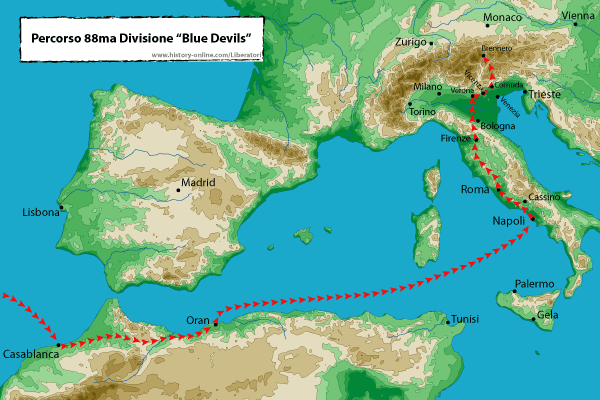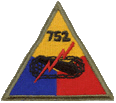The Liberators
The 88th Infantry Division “Blue Devils”

the symbol of the 88th division ''Blue Devils''
The 88th infantry division had already fought during the First World War and had been disarmed at the end of the conflict. On 15 July 1942 the division was officially reactivated at Camp Gruber in Oklahoma. Together with the 85th division it was one of the first units entirely recruited to create a fight unit that could compete with the units of the Axis.
The American army during the Second World War was entirely build-up with citizens in uniform, coming from a democratic society and not from a militarist one.
During the war preparation years, while Nazi Germany accelerated its armament and trained whole generations of Germans to military live, the United States maintained a force of only 280.000 units, but in reality, the forces were less than a half: a force not even able to ensure and defend the continent.
After being involved in the First World War, the United States was politically and strategically isolated, convinced that the irresolute tensions in Europe would soon have inflamed the continent and they aimed not to take part of it. There weren’t enough motivations for the United States society to start an armament program and to prepare an armed force.
When the United States decided that an intervention was necessary, the president’s Frankin Delano Roosevelt politics brought to the approval of different actions among which the Lend-Lease Act, thanks to which the United States began to sell and to rent enormous quantities of armaments to the Allies, increasing the industrial production, and all other mechanisms of the national war machine.
It wasn’t easy to compete with the Axis Armies because they had much more preparation and experience. The target of the activation of units such us the 88th infantry division was to form highly trained units, could choose among the ranks of the already active units and selecting among the recruits. Attends towards these units was great.
A good part of soldiers came from New England, but after some months division was integrated with citizen in uniform from every part of the United States, representing every profession and social extraction.

route of the 88th division ''Blue Devils''
The division was trained for a desert war because destined to fight in North Africa. When it crossed the Atlantic toward Casablanca in Morocco, at the end of 1943, the war in North Africa was ended; the forces of the Axis had been defeats in this theater of operations. The 88th division reached Oran and then Magenta by train, to complete a mountain war-training phase.
On February 1944, the whole division finished the long journey toward the battlegrounds and arrived in Naples, ready to face the destiny, with the target to show to be the best division employed in the theater.
The divisions entered in action during the Battle of Cassino and the advance toward Anzio and Rome and were the first Allied troops to enter Rome on 4 June 1944.
The division took part in all main actions in Italy, coming on the banks of the Po River around the 24 April 1945.
The division was also the first Allied unit to join the European front, with the 103rd American division coming from Bavaria. This happened at 10:51 on 4 May 1945.
After the end of the war against Germany, the 88th division was entrusted to guard and to check the great number of German prisoners held in many prison camps along the peninsula. One of the last duties of Italian Campaign of the 88th division was to garrison the Morgan line, (borderline between Italy and Yugoslavia). A highly risky sector where different accidents happened. The 88th division operated in proximity of Gorizia, in Friuli Venezia Julia.
General John Sloan drove the soldiers of the 88th until September 1944 and general Paul Kendall commanded the division until the end of hostilities against Germany. The general James Fry, commander of the 350th regiment who later became division commander assistant, drove the division during the prisons camps management period until November 1945 while general Bryant Moore was at the command of the division for the remaining occupation period. During the Italian Campaign, the division lost more than 11 thousand soldiers.
The 752nd Tank Battalion

the symbol of the 752nd tank battalion
The 752nd Tank Battalion wagons were one of the first units of this type activated during the second world conflict. The activation happened in January 1941 at Fort Knox, in Kentucky, nowadays site of the US Army Tank School (US Army Armour Centre).
Between April and July 1942 the unit was trained in the Mojave Desert, California, in preparation of the war in North Africa. General George Patton, a charismatic leader and pioneer of the use of armored vehicles in battle, conducted this training period.
After the training course in the homeland, the unit embarked in August 1942, directed to England for an additional training session. It arrived therefore in North Africa in January 1943 and moved in Naples in January 1944.
The unit’s fire baptism did not happen in North Africa but during the breakthrough operations of the Anzio beachhead, in May 1944. Since this moment the unit participated in many operations, showing its value and the superiority of the sustained training.
The independent tank battalions operated in support of the infantry units, usually not provided of armored vehicles. In the final phases of the Italian Campaign it supported the 34th infantry division “Red Bulls" and the 88th Infantry Division “Blue Devils". Together with the 88th infantry division they participated in the liberation of Cornuda.